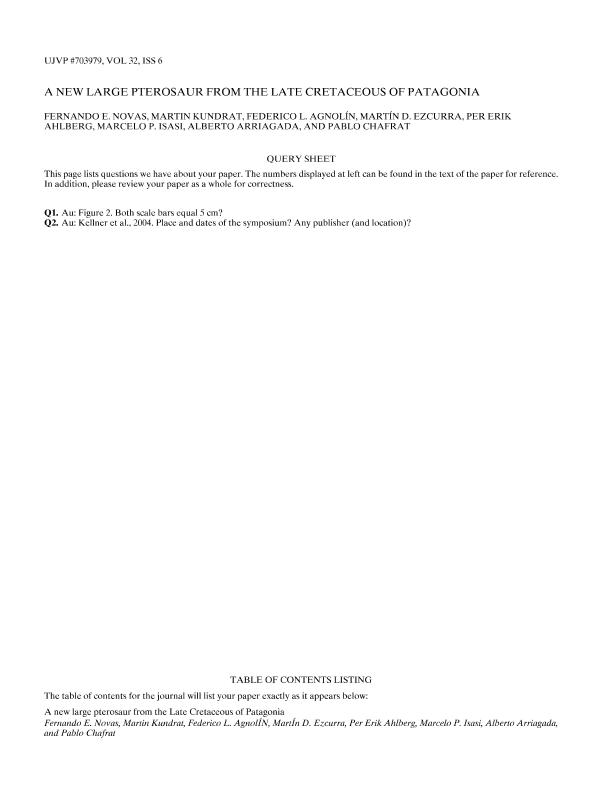Mostrar el registro sencillo del ítem
dc.contributor.author
Novas, Fernando Emilio

dc.contributor.author
Kundrat, Martin
dc.contributor.author
Agnolin, Federico

dc.contributor.author
Ezcurra, Martin Daniel

dc.contributor.author
Ahlberg, Per Erik
dc.contributor.author
Isasi, Marcelo Pablo

dc.contributor.author
Arriagada, Alberto
dc.contributor.author
Chafrat, Pablo
dc.date.available
2020-02-19T21:39:32Z
dc.date.issued
2012-11
dc.identifier.citation
Novas, Fernando Emilio; Kundrat, Martin; Agnolin, Federico; Ezcurra, Martin Daniel; Ahlberg, Per Erik; et al.; A new large pterosaur from the Late Cretaceous of Patagonia; Society of Vertebrate Paleontology; Journal of Vertebrate Paleontology; 32; 6; 11-2012; 1447-1452
dc.identifier.issn
0272-4634
dc.identifier.uri
http://hdl.handle.net/11336/98097
dc.description.abstract
South America has yielded abundant and diverse Early Cretaceous pterosaur remains, mainly from the highly productive Santana Group (Aptian-Albian) in the Araripe Basin, northeastern Brazil (Kellner, 2001; Unwin and Martill, 2007). Several pterosaur taxa have been reported from these beds, including Tapejara, Tupuxuara, and Anhanguera as the most outstanding examples (Kellner, 2001). Another highly productive Lower Cretaceous South American pterosaur-bearing unit is the Lagarcito Formation (Albian) of central Argentina that has yielded a monospecific assemblage of the pterodactyloid Pterodaustro guinazui (Bonaparte, 1970; Chiappe et al., 1998; Codorniú and Gasparini, 2007). The La Amarga Formation (Barremian-early Aptian) in northwestern Patagonia has provided an isolated pterosaur femur (Montanelli, 1987) and the Río Belgrano Formation (Barremian) in southern Patagonia has yielded an ulna and a probable partial wing metacarpal of a probable anhanguerid pteranodontoid (Kellner et al., 2003). In the Lower Cretaceous of Chile, a partial jaw with teeth and a proximal wing phalanx were assigned to an indeterminate ctenochasmatid (Martill et al., 2006). In addition, some fragmentary pterosaur remains have been reported from the Lower Cretaceous of Venezuela and Peru (Codorniú and Gasparini, 2007; Barrett et al., 2008). By contrast, the Late Cretaceous pterosaur bone record of South America is still scarce and restricted to a handful of fragmentary specimens, including remains referred to the nyctosaurid Nyctosaurus lamegoi from the Maastrichtian of Brazil (Price, 1953; Lima and Koutsoukos, 2006) and azhdarchoid long bones, probably from a taxon closely related to or a member of Azhdarchidae, from the Turonian-Coniacian Portezuelo Formation (Calvo and Lockley, 2001; Kellner et al., 2004, 2006; Apesteguía et al., 2007; Codorniú and Gasparini, 2007). Here, we expand the meager record of Late Cretaceous South American pterosaurs with the description of a partial rostrum belonging to a large azhdarchid pterodactyloid. The specimen was collected close to the Bajo de Arriagada locality, corresponding to the uppermost Cretaceous Allen Formation of Argentina, around 80 km northwest of the well-sampled Bajo de Santa Rosa locality (Martinelli and Forasiepi, 2004) (Fig. 1). The Azhdarchidae were the most abundant pterosaurs during latest Cretaceous times (Company et al., 1999; Butler et al., 2009). This clade comprises several species of long-necked pterosaurs ranging from 2.5 to 10 m in wing span, thus including the largest known flying vertebrates, such as the gigantic Quetzalcoatlus and Hatzegopteryx (Kellner and Langston, 1996; Buffetaut et al., 2002; Witton and Naish, 2008; Witton and Habib, 2010). Azhdarchid remains have been documented from almost all continental landmasses, includ- *Corresponding author. ing Europe, North America, Africa, Asia, and probably Oceania (Bennett and Long, 1991; Company et al., 1999; Averianov et al., 2005; Barrett et al., 2008; Kear et al., 2010; O˝ si et al., 2011). In South America, probable azhdarchid remains consist of a fragmentary postcranial skeleton from the Aptian of Brazil (Martill and Frey, 1998, 1999) and partial long bones from the Turonian?Coniacian of Argentina (Kellner et al., 2006; Codorni ´u and Gasparini, 2007). However, recent reassessments of this material suggested that the Brazilian specimen is more closely related to tapejarids than to azhdarchids and that the Argentinean records are dubious (Kellner, 2004; Kellner et al., 2006; Unwin andMartill, 2007). As a result, the specimen reported here represents the first unambiguous evidence of an azhdarchid pterosaur from South America. This specimen represents a new genus and species, Aerotitan sudamericanus, which is diagnosed based on a unique combination of characters, including one autapomorphy, and represents one of the largest known South American pterosaurs. The fossil here described resulted from a joint Argentine-Swedish paleontological expedition to Patagonia. Institutional Abbreviations?BSPG, Bayerische Staatssammlung für Paläontologie und Geologie, Munich, Germany; MPCNPV, Vertebrate paleontology Collection, Museo Patagónico de Ciencias Naturales, General Roca, Río Negro, Argentina.
dc.format
application/pdf
dc.language.iso
eng
dc.publisher
Society of Vertebrate Paleontology

dc.rights
info:eu-repo/semantics/openAccess
dc.rights.uri
https://creativecommons.org/licenses/by-nc-sa/2.5/ar/
dc.subject
PTEROSAURIA
dc.subject
PATAGONIA
dc.subject
CRETACEOUS
dc.subject
PALEOBIOGEOGRAPHY
dc.subject.classification
Paleontología

dc.subject.classification
Ciencias de la Tierra y relacionadas con el Medio Ambiente

dc.subject.classification
CIENCIAS NATURALES Y EXACTAS

dc.title
A new large pterosaur from the Late Cretaceous of Patagonia
dc.type
info:eu-repo/semantics/article
dc.type
info:ar-repo/semantics/artículo
dc.type
info:eu-repo/semantics/publishedVersion
dc.date.updated
2020-02-07T13:39:16Z
dc.journal.volume
32
dc.journal.number
6
dc.journal.pagination
1447-1452
dc.journal.pais
Estados Unidos

dc.journal.ciudad
Lawrence
dc.description.fil
Fil: Novas, Fernando Emilio. Consejo Nacional de Investigaciones Científicas y Técnicas. Oficina de Coordinación Administrativa Parque Centenario. Museo Argentino de Ciencias Naturales “Bernardino Rivadavia”; Argentina
dc.description.fil
Fil: Kundrat, Martin. Uppsala University; Suecia
dc.description.fil
Fil: Agnolin, Federico. Universidad Maimónides. Área de Investigaciones Biomédicas y Biotecnológicas. Centro de Estudios Biomédicos, Biotecnológicos, Ambientales y de Diagnóstico; Argentina. Consejo Nacional de Investigaciones Científicas y Técnicas. Oficina de Coordinación Administrativa Parque Centenario. Museo Argentino de Ciencias Naturales “Bernardino Rivadavia”; Argentina
dc.description.fil
Fil: Ezcurra, Martin Daniel. Ludwig Maximilians Universitat; Alemania. Consejo Nacional de Investigaciones Científicas y Técnicas. Oficina de Coordinación Administrativa Parque Centenario. Museo Argentino de Ciencias Naturales “Bernardino Rivadavia”; Argentina
dc.description.fil
Fil: Ahlberg, Per Erik. Uppsala University; Suecia
dc.description.fil
Fil: Isasi, Marcelo Pablo. Consejo Nacional de Investigaciones Científicas y Técnicas. Oficina de Coordinación Administrativa Parque Centenario. Museo Argentino de Ciencias Naturales “Bernardino Rivadavia”; Argentina
dc.description.fil
Fil: Arriagada, Alberto. No especifica;
dc.description.fil
Fil: Chafrat, Pablo. Provincia de Río Negro. Museo Patagónico de Ciencias Naturales; Argentina
dc.journal.title
Journal of Vertebrate Paleontology

dc.relation.alternativeid
info:eu-repo/semantics/altIdentifier/doi/http://dx.doi.org/10.1080/02724634.2012.703979
dc.relation.alternativeid
info:eu-repo/semantics/altIdentifier/url/https://www.tandfonline.com/doi/abs/10.1080/02724634.2012.703979
Archivos asociados
